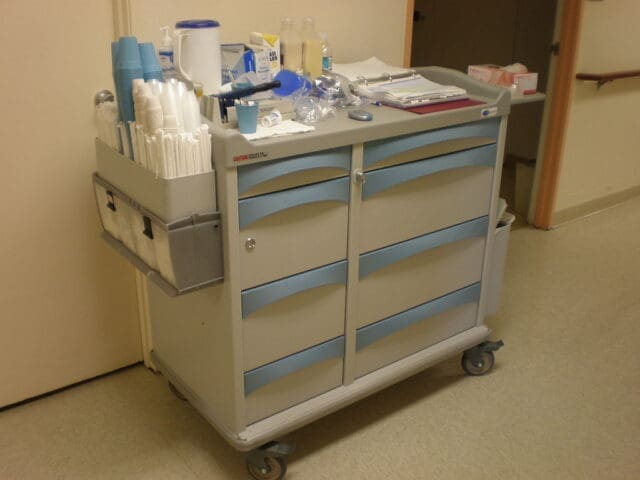During a medical emergency, fumbling around for the right tool isn’t an option. A messy supply drawer causes frustration, slows down response time, and creates an unsanitary condition. Whether it’s a large hospital or a small private practice, having a tidy medical cart is a must. Here’s how to organize a medical cart the right way:
1. Sort the Drawers
Most mobile telehealth carts have several drawers. Arranging these drawers in a clear, concise way is essential. For example, commonly used supplies such as medical tablets, which you can find here, should reside in the same section. It’s also a good idea to have a separate compartment for pediatric supplies. Be sure to lock every drawer when not in use, especially those containing needles, syringes, or medications.
Drawers get a lot of use throughout the day. Doctors and nurses often dig through them to find the right tool, and a once organized section may become cluttered. That’s why it’s wise to restock and reorganize the drawers at the start of each shift to ensure the cart is ready for anything.
2. Label Every Drawer
There’s no time to guess what’s inside each drawer of the medical cart. Many facilities have multiple carts, and workers often share them. What’s inside the top drawer of one cart may be completely different from the next. Labeling every drawer of each cart will help medical workers find what they need in a hurry.
It only takes a few minutes to label a cart properly. Each label should clearly state what’s stored inside the compartments. Instead of writing on the cart with a permanent marker, consider investing in a label maker. This way, others can create new labels if the supplies inside a particular drawer ever change.
3. Store Large Items
Not every tool fits inside a medical cart. For instance, oxygen tanks, monitors, and defibrillators are large and bulky, but workers still need to access them in a hurry. That’s why it’s necessary to find an alternative place to store larger supplies.

Storing these items in a separate room is an option, but it’s not an ideal scenario during an emergency. Instead, it’s best to keep larger supplies alongside the medical cart. Consider installing organizers, like baskets or trays, to the outside of each medical cart.
4. Identify Hazardous Items
It’s not uncommon to run across hazardous items in a medical setting. However, these supplies need to be clearly marked and carefully stored on a medical cart. Place hazardous items, such as sharps or trash, in a separate compartment. This will prevent these materials from contaminating other supplies. For added safety, make sure the chosen drawer has dual-locking capabilities.
5. Store First-Line Supplies
Some of the most commonly used supplies in a medical cart include gloves and face masks. Since these first-line supplies are non-hazardous, it’s safe to store them on the outside of the cart. Once again, attaching a basket to the side of the cart makes it easy for medical professionals to grab these items in a hurry.
Customize Every Medical Cart
Every medical facility has different needs, and these needs may change over time. That’s why it’s so important to customize every drawer and compartment of the medical cart. A well-organized cart should make it easy to find supplies quickly. Taking the time to sort all the medical carts now will help improve patient response times and accuracy.
Featured BrokenSphere, via Wikimedia Commons




